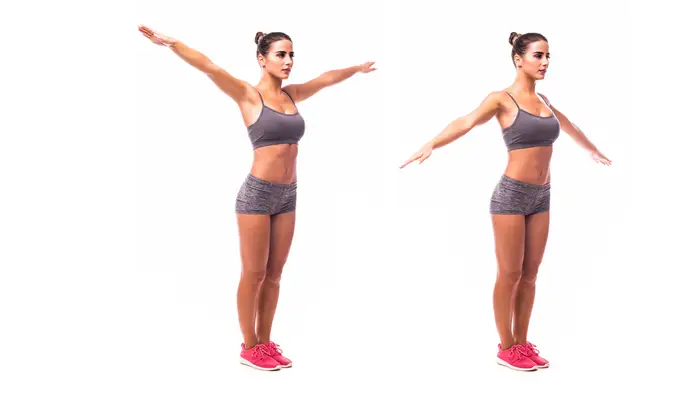The Complete Guide on Dynamic Stretches of Upper Body: Boost Flexibility, Mobility, and Injury Prevention
One type of exercise that helps you to stretch and get ready your muscles for physical activity is dynamic stretching—that is, controlled motions. Upper body dynamic stretches are energetic and fluid, unlike static stretching in which you hold a position for a long period, therefore enhancing muscle activation and blood flow. Dynamic stretches are rather essential for the upper body if you wish to increase flexibility, range of motion, and prevent injuries—especially in the back, neck, and shoulders.
Before sports, activities, or any physical exercise requiring upper body effort, dynamic stretches for the upper body should form part of your warm-up. These stretches guarantee best performance and lower the risk of damage by letting stiff muscles relax, tension to be released, and the body ready for the upcoming activities.

Why are upper body dynamic stretches so important?
Increases Flexibility and Range of Motion
Upper body dynamic stretches will assist you to move more naturally during physical exercise, so enhancing your range of motion. Regular stretching helps to keep muscular suppleness and joint mobility, which are qualities needed to avoid stiffness and pain. More range of motion helps you to do workouts with better form and technique, thereby enhancing your whole athletic performance.
Boosts Blood Flow and Gets Muscles Ready for Business
Before any intense exercise, warm-up of your muscles will enable you to increase performance and avoid damage. Dynamic stretching guarantees that your muscles and joints are hydrated and ready for usage by increasing blood flow. Warm-up upper body dynamic stretches increase muscle flexibility, so lowering your chance of sprains or strains during your workout.
Lowers the risk of neck, back, and shoulder injuries
In those with a sedentary lifestyle or repeated motions specifically, the upper body—especially the shoulders, back, and neck—is prone to stress and stiffness. Dynamic stretching increases blood flow and flexibility, therefore reducing the chance of injuries in these regions. Maintaining the muscles and joints in these regions enables you to handle physical demands without overstressing.
Perfect for sports, warm-ups before an exercise, any upper body workout
Upper body dynamic stretches must be consistent if one wants to maximize their advantages before an exercise or physical activity. Your program should get your muscles ready for the demands of whatever it asks for—running, weightlifting, sports, even desk work. Dynamic stretches give a strong platform for the later motions and substantially improve the quality of your training. These should form part of your warm-up.
Top Upper Body Dynamic Stretches to Boost Flexibility and Mobility
Arm circles
Methods of Execution:
- Stretch your arms out at your sides shoulder height.
- First draw little circles, then progressively larger ones.
- Go 10 to 15 rounds one way then turn to the other.
Arm circles are one great way to increase shoulder flexibility and mobility. Crucially, they lubricate the shoulder joints and improve blood flow to the upper body before engaging in exercises demanding shoulder strength and endurance.
- Common Mistakes to Prevent too quickly stretching the arms: slowly widen your circles to avoid stressing the shoulders.
- Not influencing the central point: Keeping your core turned on will help you to maintain better stability and posture throughout the exercise.

2. Turns in the Torso
- Standing with your feet shoulder-width apart, extend your arms front of you.
- Keeping your hips forward, gently twist your torso toward the left then turn to the right.
- Emphasize the rotation coming from your spine and do 10–15 twists on each side.
Torso twists are great for warm-up of the back, spine, and core muscles. Particularly important for sports incorporating rotation, like tennis, golf, or swimming is spinal flexibility and enhanced general mobility.
- First give breathing and alignment paramount importance.
- To prevent any tension, inhale as you twist and exhale as you return to center keeping a neutral spine throughout along the workout.
3. Chest opening tools
- Staying with feet hip-width apart, clasp your hands behind your back.
- Breathe opening your chest; gently straighten your arms and lift them away from your body.
- Five to ten seconds then let go and repeat from the same stance.
This stretch works the shoulder and chest muscles, therefore offsetting the consequences of bad posture resulting from slouching or desk-based sitting. From chest openers, those who spend a lot of time hunched down could find great relief from upper body stress.
Typical Errors to Do:
Pulling too forcefully on your arms runs the risk of worsening overstretching of shoulder problems. Stress on progressively free from tension opening the chest.

4. For the shoulders, roller motions
- Having your feet shoulder-width apart, let your arms rest at your sides.
- Roll your shoulders gently forward in a circular pattern, then turn around.
- Every direction, do ten to fifteen shoulder rolls.
Apart from upper back discomfort, shoulder rolls help to release shoulder stress and stiffness. By way of the muscles supporting the neck and upper spine, this basic but efficient exercise also improves posture.
Correct posture: How shoulder rolls
Frequent shoulder rolls help to improve general posture throughout the day by means of better alignment of the shoulders and upper back, therefore lowering the risk of slumping.
The side bend’s overhead reach
- Get tall with arms up high and feet hip-width apart.
- Lean gently to one side, then back to the middle and stretch your arm as far as you can.
- From yet more another viewpoint.
- Working on the sides, upper back, and shoulders, this stretch increases shoulder mobility and flexibility of the torso. This is an excellent approach to increase lateral flexibility and work the whole upper body.
- First give retaining a neutral spine top importance.
- Stretch without leaning over or arching your lower back. Keeping a neutral spine will reassure a powerful and safe stretch.
5. Scapula Push-Ups from
How am I supposed to do it?
- From a plank position, have your hands exactly beneath your shoulders and your arms completely stretched.
- Retraction of your shoulder blades will lower your chest close to the ground without elbow bending.
- Reversing, protract your shoulder blades; then, repeat 10 to fifteen times.
Ad benefits:
Perfect for building the muscles surrounding the shoulder blades, scapular push-ups also help to increase general shoulder mobility and shoulder stability. Particularly in weightlifting or sports needing overhead motions, they are highly effective in avoiding shoulder issues.

When might one use dynamic stretches for the upper body?
Your upper body should mostly benefit from dynamic stretches during your warm-up before physical activity. They can also be useful for:
Warm-up prior to-work: Key for waking muscles before aerobics, strength building, or any hard upper body exercise.
Perfect for getting the body ready for basketball, swimming, or tennis, sports or athletic performance office breaks call for upper body mobility. Simple stretches include shoulder rolls and torso twists can help with stress from prolonged sitting and improve posture all day.
Mistakes to Avoid During Upper Body Dynamic Stretching
- Stressing muscles: Try not to strain very hard with every stretch. Stress thoughtful motions and slow flexibility increases.
- Instead than being hurried, dynamic stretches should be methodically under control. Their almost instantaneous performance is Short movements can strain or damage muscles.
- Denying Form and Correct Posture: One can help by keeping your alignment all during each stretch. Bad posture can tax joints and muscles.
Start with a light warm-up, say running in place, then dynamically stretch to prevent damage.
Including active stretches for upper bodies to your program:
Write a daily calendar. Including these stretches in your regular exercise can assist to increase mobility and flexibility. Run them often if you want optimal benefits.
- Time and repetitions: For every stretch, try 10 to 15 repetitions; hold at the conclusion of each motion for one to two seconds. Emphasize controlled motions over extended spans of time.
- Couple performing more warm-up exercises: Before your active stretches, include light running or jumping jacks, which raise heart rate.
Basically
Dynamic stretches for the upper body serve to increase range of motion and prevent injuries. These stretches help you to guarantee that your joints and muscles are ready for physical exercise, thereby lowering your chance of injuries and improving your performance. Frequent use of these stretches in your warm-up or even regular exercise will help you to improve posture and increased mobility.
